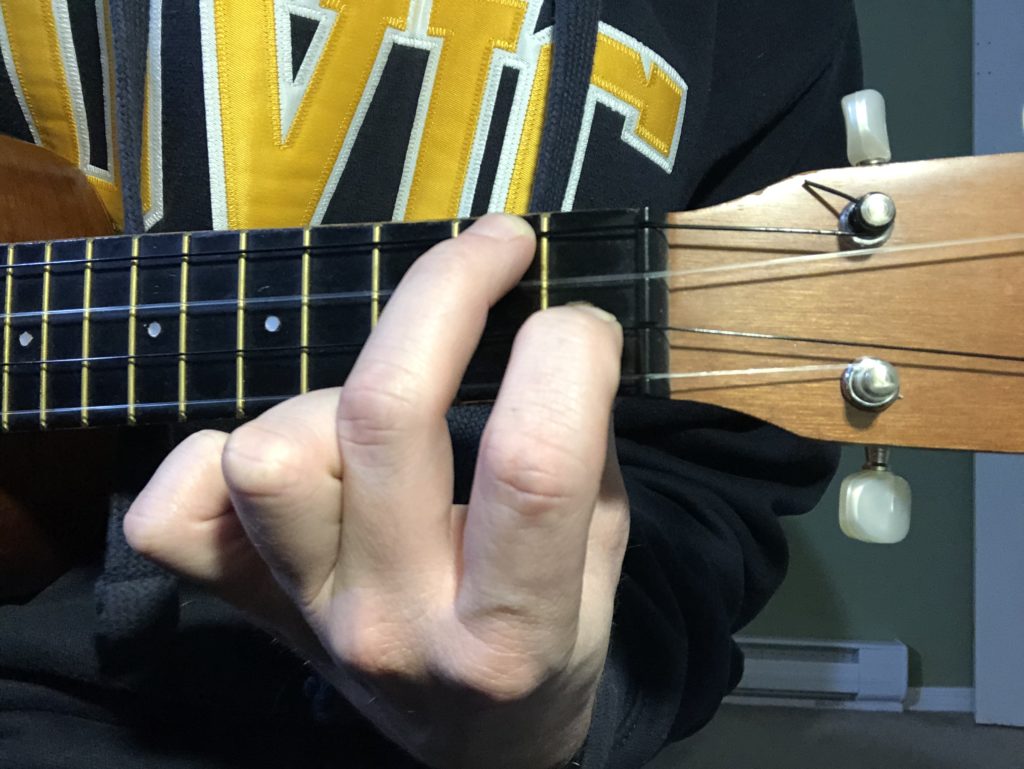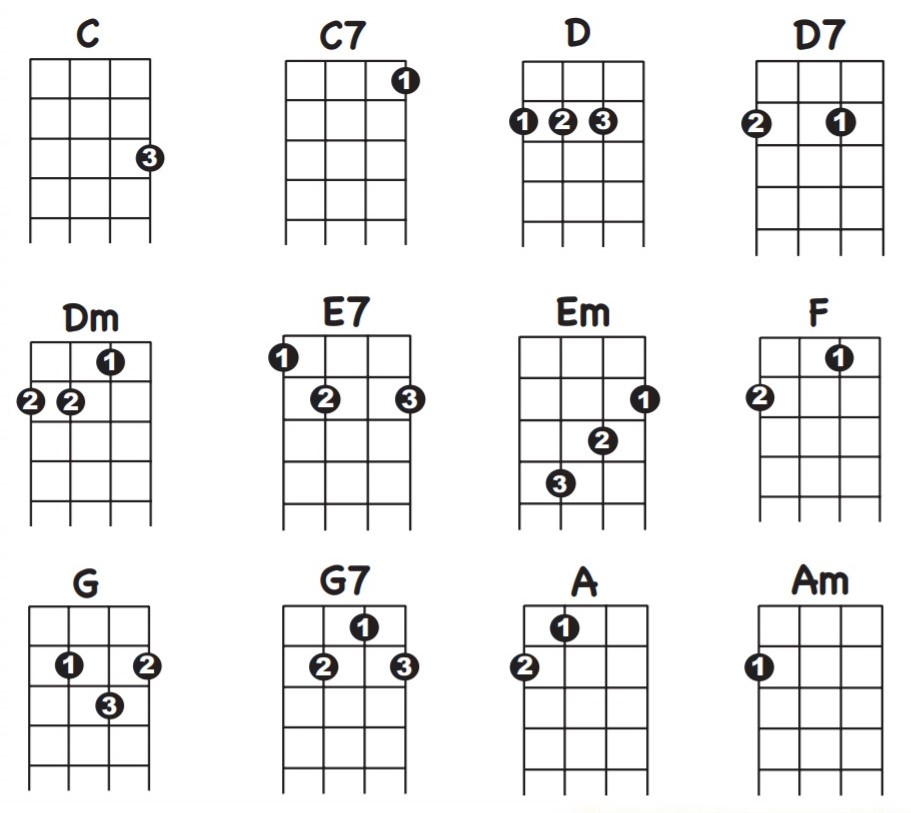Category: EDCI306A
Playing the ukulele has proven to be a fun and difficult journey!
From changing my ukulele from the key of D to the key of C, learning new chords, and deciding which songs to play, so far the ukulele has been quite the learning experience!
Originally, on my Musical Growth Plan, I listed that I planned on learning and demonstrating songs such as “Little Tommy Tinker”, and “Johnny One Hammer”, which would have been played using the chord of D (if tuned to key of D), or the chord of C (if tuned to the key of C).
I have practiced these songs and have decided to challenge myself and work on a more complicated song. I have chosen to practice and demonstrate the song “Hush Little Baby”, which use the chords F and C7.
I chose this song to challenge myself and my hand coordination. I have found it difficult to transition between chords, but I believe I am making progress!
Another challenge that I am having is strumming. I have seen various people strum different ways and I am unsure if I am using an acceptable method. I have seen some players use an open hand method, where they strum down with their thumb and up with their index finger. I have also witnessed musicians pinching both their thumb and forefinger together and using this to strum up and down. Additionally, I have seen ukulelists have their ukulele resting on their hip, or thigh if sitting. I have also been instructed that the ukulele should be held up with the body of the ukulele resting in the crook of your arm. All of these are somewhat contradictory of each other and are a little confusing for a beginner such as myself. This just demonstrates some of the possible roadblocks of learning an instrument at home.
Below is a link to the video of myself attempting the song, “Hush Little Baby”. Filming this video was a true test for me. Digital stage fright and the inability to sing led to some internal struggle. But I was able to push through it and ultimately I’m happy with what I was able to produce, even if it is not perfect!
Thank you for watching and reading! I am very proud of the progress that I have made so far, and I look forward to reflecting on my musical journey at the end of the term and admiring how far I’ve come!
At the beginning of my musical journey in EDCI306A I was not entirely sure what a chord was. I have heard the term in the past, but it was not one that I could clearly define.
I know now that a chord is a set of musical notes played at the same time harmoniously. Instruments such as the piano and the guitar (and of course the ukulele) are able to play chords as they can play multiple notes at once.
A key part of learning the ukulele is learning the various chords and the hand/finger positions that they require. This has been quite the learning curve for me. Positioning my left hand in a claw-like position while placing my fingers awkwardly on the strings has been a struggle for sure. I am severely right handed and using my left hand has been a test of my ambidexterity. I can now see how learning an instrument can positively affect a students physical development.
Originally, I had set the goal of learning three chords in the key of D. The chords were: D, A7, and G. Since then I have had to tune my ukulele to the key of C, which changes the chords that I will be learning. At the moment I have been focusing on the chords C, F, and C7.
Looking at the chord chart provided by MusicPlayOnline, I believe that these chords might be the easiest to learn and will provide me with the practice of finger position and transitioning between chords. Once I have mastered these three I will then attempt at experimenting with some of the trickier chords and finger positions.
Below are some images of myself displaying the finger positions for the three chords that I am learning. I learned through taking these images that I am not very quick at my transitions and that it is awkward to take a picture of yourself displaying different chords.
Chord C:

Chord C7:

Chord F:

Throughout the upcoming weeks I will be continuing my practice of these chords and my transitions between them. I hope to be able to put them into practice by learning and performing the songs, “Johnny One Hammer” and “Hush Little Baby”.
Next post will be an exciting one! Stay tuned for the (not-so) velvety voice of moi, and the (hopefully) successful performance of “Hush Little Baby”.
Starting a musical journey, such as the one we are taking as teacher candidates, can be both exciting and a little nerve wracking. Having to learn all of these musical concepts, apply them in practice, and learn a new instrument, is a lot to take in.
Fortunately for me, I played the B♭ clarinet for about 5 years, and the bass clarinet for about 2 years, during elementary and middle school. I even had my very own white B♭ clarinet! Unfortunately, I have not played within the past 15 years. This means that much of the musical concepts that we’ll be covering is in my brain somewhere, it’s just buried deep in a dusty corner in the back of my mind.
My first goal for this term is to remember how to read a sheet of music. Some terms jumped out to me right away, such as crescendo or staccato, while some took a moment to resurface. I even felt a little embarrassed by myself when we were shown a few measures with notes, and I could not remember the names of each of the notes. It was not until Dr. Prest provided us with a mnemonic to remember the notes that I began to recall them all.
I don’t remember the exact mnemonic that Dr. Prest gave us, but I was able to remember the one that I learned as a child. It goes like this, “Every Good Boy Deserves Fudge”.
Thinking about it now, this is not a mnemonic that I would use to teach students today. I would find or develop a mnemonic that is gender neutral or refers to objects rather than people.
After a quick Google search, I found other useful mnemonics such as:
- “Every Good Band Draws Fans” – dummies.com
- “Empty Garbage Before Dad Flips” – Nandua Middle School
and
- “Elephants Go Break Dancing Fridays” – Nandua Middle School
Another challenge that I encountered is learning the ukulele. My experience with woodwind instruments is moderate, but my experience with string instruments is non-existent. Even the concept of tuning every time I play is odd, and so far my experience with tuning has not been fun!
The ukulele that I am renting was originally tuned to the key of D. Not long after I picked it up I noticed that two of the strings were sounding very similar and none of them really sounded like they should, as demonstrated by the tuner on MusicPlayOnline. I then decided to set out and download a tuner to my phone. I downloaded a few that were “free”, but after I used them to tune once they then required me to pay a subscription fee. I decided to try other options. I found a few others, but either they were free for the first week, or they only tuned to the key of C. I would have gone to UVic to have my ukulele tuned, but I often am unable to make it there when the music department is open due to class times and my work hours. It also isn’t realistic as the ukulele requires frequent tuning.
After much frustration with tuning I decided to simply tune my ukulele to the key of C. I was happy with my decision as I was able to easily tune it, and when we had our like-instrument peer session within EDCI 306A I discovered that everyone else’s ukuleles were also tuned to the key of C. This will make it easier for future discussions and peer sessions.
Overall my musical journey within EDCI 306A has been fun and positive! I look forward to what comes next, and to my ukulele-learning journey!
Next time, we’ll see if I can demonstrate these odd things called “chords”!




Recent Comments